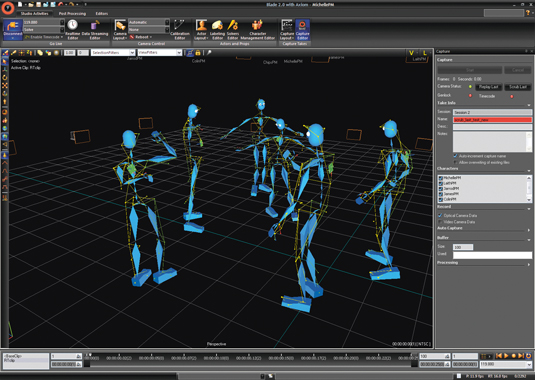Why motion capture is set to radically change in 2015
Vicon’s Phil Elderfield discusses the changing face of mocap technology.
Motion capture effectively allows shooting infinite angles in one take. This enables you to defer some of the decision-making process to later in the production pipeline and allows for creative flexibility.
While we have a long way to go, it seems the logical conclusion of all this is the complete replacement of traditional 2D cinematography with 3D capture for every production type. Motion capture becomes digital cinematography, a kind of 'captography'.
Not only does mocap provide a superior tool for pre-visualisation and shot planning to help the decision-making process early on, but also increased flexibility will provide for experimentation at all stages of production, promising almost infinite creative possibilities, but exploited with structure and within budget and schedule constraints.
It will become more and more important that the director, performers and crew are able to visualise and explore the digital environment in real-time as they shoot, and this will require reduction in system footprint and increase system transparency – motion capture must perform unobtrusively on the film set. For more advances, see our selection of 2015's hottest design tools.
Real-time virtualisation
I believe we are already taking strides in this direction. That said, there is a great deal to be done before it becomes close to reality and the barriers are as likely to come from acceptance by some of the more intransigent areas of the industry as from the technology.
Motion capture alone will not make this possible. Significant advances are required in rendering, lighting, modelling, simulation, hardware and software, across the face of digital production, to achieve photo and motion realism comparable with current digital photography. For games, there has been a move in recent years towards mobile gaming, which doesn’t always demand the same level of detail or narrative thread found in console counterparts.

However, narrative will always be part of the picture and in my opinion, story and character driven games will remain a vibrant part of the mix. Increased believability of performance, both in game and in cinematic form, will allow the player to connect with characters in much more complete ways. Ongoing improvements in immersive technologies and the drive toward wearable tech, can, and will, exploit and compliment motion capture techniques. These technologies combined, will grow in importance for both content creation and player immersion.
Get the Creative Bloq Newsletter
Daily design news, reviews, how-tos and more, as picked by the editors.
Many of these advances will come through software and processing, where much more will be made of limited data sets. This will help make motion capture truly accessible to a wider range of user, and usable in the most difficult of environments, as well as improving the quality of the end product. In hardware, robustness and reduction in footprint and physical impact will make the technology recede, and allow the creative process to flourish.

Capture technologies
Complimentary data acquisition sources may be used to increase the pool of information on which the clever processing can work, each source overcoming limitations of its counterparts. The evolving discipline of facial capture is key to the delivery of computer-generated imagery, which is as representative of an actor’s performance as its camera-generated counterpart. Work currently underway in this area, driven by obvious demand, will lead to methods both unobtrusive and accurate.
Another area where we will see expansion of the use of capture technologies is in broadcast
Another area where we will see expansion of the use of capture technologies is in broadcast, where real-time interactions in virtual worlds will become more commonplace for viewers and participants, and as a production technique. The immediacy of the current level of real-time feedback offers intriguing possibilities for the world of TV production and I believe we’ll see more evidence of this over the coming years.
Despite its 30-year history, its ubiquity, and the transition of motion capture from the magical to the commonplace, I cannot help feeling that actually we are on the verge of a new and significant period of virtual entertainment, where motion capture and completely new technologies are set to radically change, for the better, the way we produce and experience our art and entertainment.
Words: Phil Elderfield
Phil Elderfield has a background as a film editor and a first class bachelor’s degree in computer science. Phil’s combined skills are put to use in his role as product manager, media and entertainment, Vicon. Follow Vicon at Twitter at @Vicon.
Like this? Read these!
- How to extract leaf textures with Photoshop
- 10 top character design tips for animation
- How to create fabric stitches in Photoshop
- The best 3D movies coming in 2014
Have see a great piece of work that employs motion capture? Let us know about your experience in the Comments!

Thank you for reading 5 articles this month* Join now for unlimited access
Enjoy your first month for just £1 / $1 / €1
*Read 5 free articles per month without a subscription

Join now for unlimited access
Try first month for just £1 / $1 / €1

The Creative Bloq team is made up of a group of art and design enthusiasts, and has changed and evolved since Creative Bloq began back in 2012. The current website team consists of eight full-time members of staff: Editor Georgia Coggan, Deputy Editor Rosie Hilder, Ecommerce Editor Beren Neale, Senior News Editor Daniel Piper, Editor, Digital Art and 3D Ian Dean, Tech Reviews Editor Erlingur Einarsson, Ecommerce Writer Beth Nicholls and Staff Writer Natalie Fear, as well as a roster of freelancers from around the world. The ImagineFX magazine team also pitch in, ensuring that content from leading digital art publication ImagineFX is represented on Creative Bloq.
